Hunting for magnetic monopoles with the Universe's strongest magnetic fields
18 July 2024 | By
What if a particle could have only a single north or south pole, making it magnetically charged? For over a century, physicists have been searching for such magnetic monopoles. These hypothetical particles were first postulated by physicist Paul Dirac in 1931. They would demonstrate the complete symmetry between electricity and magnetism, moving in a magnetic field the way an electron moves in an electric field. Their existence might also confirm aspects of grand unified theories, in which there is a unification of Standard Model forces at very high energies.

Researchers at the Large Hadron Collider (LHC) are searching for monopoles produced in high-energy collisions. Monopoles would be highly ionising, meaning they would strip electrons from atoms and would leave behind significant energy deposits in detectors. ATLAS physicists previously searched for distinctive monopole signatures using proton-proton collision data from Run 1 (2010-2012) and Run 2 (2015-2018) of the LHC, with no signal found.
In a new result from the ATLAS Collaboration, physicists analysed the first Run-3 heavy-ion collision data collected in the autumn of 2023. Specifically researchers looked at “ultraperipheral” collisions, where ions pass at a distance precluding hadronic interactions yet close enough to interact through electromagnetic fields. These interactions can produce the largest magnetic fields in the Universe, with strength up to 1016 Tesla.
Physicists from the ATLAS Collaboration searched for magnetic monopoles produced in the largest magnetic fields in the Universe.
If magnetic monopoles were produced in such interactions, they would be the sole particles to be found in an otherwise empty detector. The monopoles would manifest themselves as a concentrated cloud of signals (or clusters) from low-momentum secondary electrons (also known as delta rays) in the Pixel detector, an innermost ATLAS sub-detector (see Figure 1).

The unique features of the expected signal meant that the primary background of the analysis would come from beam-induced particles reaching the ATLAS experiment at a very small radial range. In other words, these particles would not be generated in the ultraperipheral collisions but rather from the LHC beamline. Researchers estimated they would see four such background events in their study. Observations were consistent with this estimate, with only three events detected. Consequently, the new ATLAS result sets the world's best limits on the production rate (or cross section) of monopoles produced in ultraperipheral heavy-ion collisions for monopole masses below 120 GeV (see Figure 2). By studying the properties of clusters reconstructed in the innermost silicon detector layers, this new measurement introduces a methodology for studying highly ionising particles in heavy-ion data at the LHC and beyond.
With more heavy-ion data expected in 2024 and 2025, ATLAS physicists will continue their quest to find magnetic monopoles and other exotic highly-ionising particles at the LHC – all while further refining their search techniques and developing new experimental strategies.
Learn more
- Search for magnetic monopole pair production in ultraperipheral Pb+Pb collisions at 5.36 TeV with the ATLAS detector at the LHC (ATLAS-CONF-2024-009)
- ICHEP 2024 presentation by Krzysztof Cieśla: Search for monopole production in ultraperipheral Pb+Pb collisions with the ATLAS detector
- O. Gould, D. Ho and A. Rajantie, Towards Schwinger production of magnetic monopoles in heavy-ion collisions (Phys. Rev. D 100 (2019) 015041)



